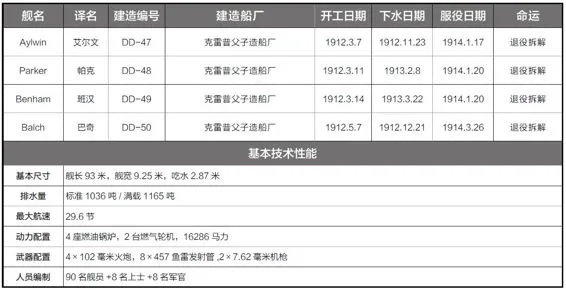Aylwin class
At the same time that the construction of the thousand-ton "Cassin" class destroyer began, the U.S. Navy began the construction of the second class of "thousand-ton destroyer", which is the "Alvin" class. From the design point of view, the "Alvin" class and the "Cassin" class destroyer can be said to be exactly the same, and they also use the upper and lower deck design. The Alvin class had four 102 mm guns, one at the bow, two on the central axis, and one aft. In addition to the artillery, the ship was equipped with four twin torpedo tubes. Unlike the Cassin class, the Elvin class was fitted with two 7.62 mm machine guns to enhance air defense capabilities, and its stern was fitted with two depth charge launchers to enhance anti-submarine capabilities. The Alvin class was fitted with a fuel-fired boiler, four of which were connected to four chimneys. Only two three-stage expanding gas turbines were installed on the Alvin class, but with an output of 16,000 horsepower and a maximum speed of more than 29 knots.
Construction began on 7 March 1912 on the first ship of the Alvin class, the destroyer HMS Alvin (DD-47), at the Crep Father and Son Shipyard, and the other three ships of the class (DD-48 to DD-50) were also built at the Kleep Father and Son Shipyard. All Of the Alvin classes were launched and served between 1912 and 1914. The Alvin-class destroyers have been on duty in the Atlantic and Caribbean since they entered service. On April 6, 1914, the "Alvin" was repaired after an accidental explosion caused a fire that killed 2 crew members. In October 1916, before the outbreak of World War I, a British cargo ship was sunk by the German Navy's U-53 submarine in the Atlantic Ocean, and the U.S. Navy, which received a distress signal, sent several destroyers, including the Alvin, to rescue five survivors. After the United States entered the war, the "Alvin" class became the first American destroyer to carry out escort missions in the Atlantic, during which they fought german submarines several times, but the results of the battle were unknown. In September 1917, during a mission, the destroyer Banhan collided with the British gunboat Pertussus and almost sank, which was later repaired.
After World War I, all members of the Alvin class retired from 1921 to 1922. In 1935, all Of the Alvin-class destroyers were eventually sold and dismantled under the London Naval Treaty. The "Alvin" class is the second class of the American "thousand-ton destroyer", as a kind of ocean-going large destroyer, it played an important role in the escort operations of World War I.
